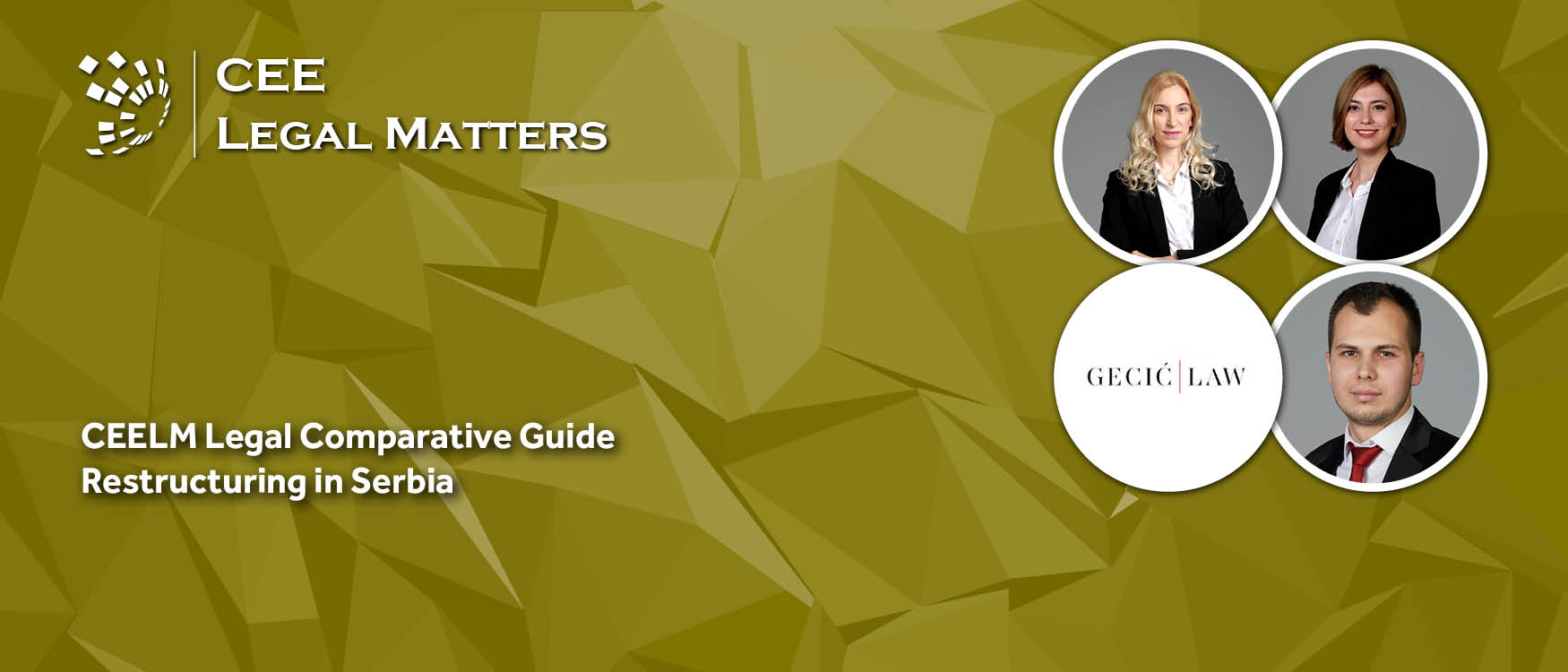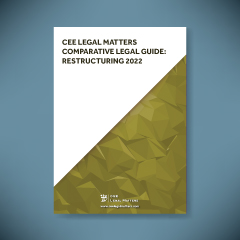Contributed by Gecic Law.
1. Overview
1.1. What domestic pieces of legislation and international instruments apply to restructuring and insolvency matters in your jurisdiction?
The primary legislation governing insolvency and restructuring proceedings consists of the Bankruptcy Act (Official Gazette of the Republic of Serbia nos. 104/2009, 99/2011, 71/2012, 83/2014, 113/2017, 44/2018, and 95/2018), the Act on Bankruptcy and Liquidation of Banks and Insurance Undertakings (Official Gazette of the Republic of Serbia nos. 14/2015 and 44/2018), and the Consensual Financial Restructuring Act (Official Gazette of the Republic of Serbia nos. 89/2015). Serbian corporate and labor law regulations apply to restructuring proceedings outside of insolvency proceedings.
1.2. Do you have a well-established legal regime governing restructuring and insolvency, or do you have rather frequent legislative changes in the area?
Serbia has a well-established legal regime governing restructuring and insolvency.
1.3. Are there any special regimes applying to specific sectors?
Yes, a special regime applies to banks and insurance companies.
1.4. Were any changes to restructuring or insolvency laws adopted in response to the COVID-19 pandemic? If so, what were they?
No changes regarding restructuring or insolvency laws were adopted in response to the COVID-19 pandemic.
1.5. Are there any proposed or upcoming changes to the restructuring insolvency regime in your country?
There are no proposed changes to the restructuring insolvency regime in Serbia. However, as of 2021, a draft for the Amendments to the Bankruptcy Act has been announced.
1.6. Has your country adopted or is your country considering the adoption of the UNCITRAL Model Law on Enterprise Group Insolvency?
Serbia has not adopted the UNCITRAL Model Law on Enterprise Group Insolvency but has adopted the UNCITRAL Model Law on Cross-Border Insolvency.
2. Insolvency
2.1. Is there an insolvency test that triggers certain obligations for directors or officers of the debtor company? If so, what is the test and what are the consequences for failure to meet these obligations?
N/A
2.2. What types of insolvency procedures are established by law in your jurisdiction?
The Bankruptcy Act establishes two types of insolvency procedures:
1) Bankruptcy – the settlement of creditors from the entire property value of the debtor.
2) Restructuring – the settlement of creditors according to the adopted reorganization plan (redefining debtor-creditor relations, status changes of the debtor, or another manner provided for in the reorganization plan) (see Section 3.).
2.3. Who has the right to initiate insolvency proceedings?
Bankruptcy proceedings can be initiated by creditors, the debtor itself, or a dissolution trustee.
2.4. What are the consequences of commencing insolvency proceedings, in particular:
2.4.1. Does management continue to operate the business and/or is the debtor subject to supervision?
As of the day of commencement of insolvency proceedings, management ceases to operate the business, with exception of the potential finalization of already initiated operations which is subjected to the approval of the creditor’s board. When the bankruptcy proceedings are formally initiated, the representative and management rights of the directors, representatives, and attorneys, as well as the management and supervisory bodies of the debtor cease and are transferred to the bankruptcy trustee. The bankruptcy trustee is a legal representative of the bankrupt debtor.
2.4.2. Does a moratorium or stay apply and if so, can it have an extraterritorial effect?
Moratorium – if found necessary, the court may impose a moratorium as one of the security measures provided by the applicable law. A moratorium can be imposed solely, or alongside other security measures.
The Bankruptcy Act does not allow stay.
2.4.3. How does it impact the existing contracts (e.g. is the counter-party free to terminate them, can the debtor’s pre-insolvency transactions be challenged)?
On the day of the opening of bankruptcy proceedings, all creditors’ claims against the debtor, which are not due, are considered due (not vice versa) and can be realized (i.e., collected) exclusively under the rules of bankruptcy proceedings. In cases in which compensation of mutual claims is allowed under the Bankruptcy Act, a request for compensation must be presented within the deadline for submission of the claim application.
In the case of non-fulfilled existing contracts, the bankruptcy trustee can decide to fulfill the contract (instead of the bankrupt debtor) and demand fulfillment from the other party.
If the bankruptcy trustee refuses to keep the contract in force, the other party can realize his claim as a bankruptcy creditor.
The debtor’s pre-insolvency transactions can be challenged under the rules of the Bankruptcy Act. In a case when is determined that the debtor’s pre-insolvency transactions disrupt the settlement of bankruptcy creditors or damage creditors, i.e., put individual creditors in a more favorable position, the transactions may be challenged by the bankruptcy trustee (on behalf of the bankruptcy debtor and creditors). The legal business or legal action of the debtor may be contested through a lawsuit.
2.5. Which steps do insolvency proceedings normally include and what are the roles of the courts and other key stakeholders (such as debtor, directors of the debtor, shareholders of the debtor, secured creditors, unsecured creditors, etc.)?
The steps that insolvency proceedings normally include are the following:
- Initiation of bankruptcy proceedings by filing a bankruptcy petition (see Section 2.3.).
- Deciding on the initiation of preliminary proceedings by the court whose main goal is to determine the existence of bankruptcy grounds and in which phase certain preliminary measures can be adopted in order to secure debtor’s assets (e.g., ban of payments from debtor’s bank account).
- Passing the decision on opening the bankruptcy proceedings, which sets the dates for the first creditors’ hearing (in which the Creditor’s Board is appointed) and examination hearing (on which creditors can contest other creditors’ claims).
- When the bankruptcy proceedings are opened, the representative and management rights are transferred to the bankruptcy trustee (see Section 2.4.).
- The bankruptcy trustee compiles a list of all known creditors.
- Creditors submit their claims to the competent court. After the expiration of the deadline for reporting claims, the court delivers all claims reports to the bankruptcy trustee.
- The bankruptcy trustee determines the merits, scope, and payment order of each claim and, in doing so, compiles a list of recognized and contested claims, as well as the order of settlement of separate and lien creditors.
- The final list of all claims reports is drawn up at the examination hearing.
- In case the petition for reorganization is not passed, the bankruptcy trustee takes measures on selling the debtor’s assets.
- Upon selling all the available assets, the bankruptcy trustee drafts a decision for the main division of the bankruptcy estate, subject to creditors’ right to object.
- The court decides on the main division of the bankruptcy estate and conducts the main division of the bankruptcy estate.
- The court issues a decision on closing the bankruptcy proceedings at the final hearing.
The key participants in bankruptcy proceedings are: 1) the competent court, 2) the bankruptcy trustee, 3) the Creditors’ Meeting, 4) the Creditors’ Board, 5) individual creditors
- The role of the competent court is to fully conduct and manage bankruptcy proceedings. The courts conduct bankruptcy proceedings ex officio. However, the competent court is entitled to decide on the initiation of preliminary bankruptcy proceedings, determines the existence of bankruptcy grounds, decides on the opening of bankruptcy proceedings, appoints, and dismisses the bankruptcy trustee, approves the costs of the bankruptcy proceedings and the obligations of the bankruptcy estate. etc.
- The bankruptcy trustee represents the bankruptcy debtor in all affairs related to bankruptcy proceedings (See Section 2.4.).
- The Creditors’ Meeting consists of all creditors of the bankruptcy estate. It decides on the continuation of bankruptcy proceedings through reorganization or bankruptcy, reviews the reports of the bankruptcy trustee, etc.
- The Creditors’ Board consists of a maximum of seven creditors and renders an opinion on the continuation of ongoing affairs of the debtor, monitors the operations of the bankruptcy trustee, and provides consent for certain actions (e.g., the decision on the manner of selling of debtor’s assets), examines the final report of the bankruptcy trustee, and reports on developments in proceedings to the Creditors’ Meeting, etc.
- Individual creditors, based on the type of their claim, can be (i) unsecured creditors which are settled in accordance with general payment orders (ii) secured creditors which have priority in settlement from pledge on the securing their claim (iii) pledge creditors who only have the pledge on debtor’s asset and not a claim against it.
2.6. In insolvency proceedings, do specific stakeholders’ claims enjoy priority (e.g., employees, pension liabilities)? Can the claims of any class of creditor be subordinated (e.g., equitable subordination)?
In the Republic of Serbia, bankruptcy creditors are placed in payment queues, depending on their claims, meaning specific creditors’ claims enjoy priority.
1) the first payment order includes the unpaid net wages of current and former employees at the minimum rate for the year preceding the formal initiation of bankruptcy proceedings and unpaid contributions;
2) the second payment order includes claims based on all taxes due in the last three months before the opening of bankruptcy proceedings;
3) the third payment order includes the claims of unsecured bankruptcy creditors;
4) the fourth payment order includes unsecured loans given by its affiliated companies in the last two years.
2.7. What is a timeline for insolvency proceedings and how are they finalized?
There is no final deadline for the completion of bankruptcy proceedings. However, the Bankruptcy Act sets the principle of urgency which means stoppages and interruptions are not allowed. In this procedure restitutio in integrum is not allowed and it is not possible to declare an extraordinary legal remedy or to request a retrial. Furthermore, the court may decide on outside hearings.
2.8. Are there any liabilities that survive the insolvency proceedings?
N/A
3. Restructuring
3.1. What formal and informal restructuring proceedings are available in your country?
There are no available informal restructuring proceedings in Serbia. Restructuring proceedings are regulated by the Bankruptcy Act and are formally led by the bankruptcy court. The key document in restructuring proceedings is a reorganization plan (regular or pre-packed reorganization plan) which is an act of mixed legal nature – it is a contract between a debtor and its creditors, created under the control of and approved by a court, which alters the debtor’s liabilities, generally via partial write off or deadline rescheduling
3.2. What are the entry requirements to restructuring and how are restructuring plans approved and implemented?
A company may undergo restructuring proceedings in case it is unable to pay off its debts and restructuring is a more favorable way of paying off the liabilities than undergoing bankruptcy proceedings.
A reorganization plan may be filed along with a bankruptcy petition (pre-packed reorganization plan), or during the ongoing bankruptcy proceeding (under the term of 90 days from bankruptcy opening. In these cases, the court decides on commencing and schedules a hearing to discuss whether the conditions for initiating the bankruptcy procedure are met (preliminary proceedings are optional). In preliminary proceedings, the court may engage a professional to validate the data from the reorganization plan. In addition, during preliminary proceedings, the court may impose measures to prevent changes in the financial state of the debtor.
If the reorganization plan is not dismissed, the court schedules a hearing to discuss and vote on the proposed reorganization plan. Creditors are classified in at least two classes based on the priority of their claims and securities, and the reorganization plan is deemed accepted if it is accepted within all classes of creditors.
3.3. Who has the right to initiate formal restructuring proceedings?
Bankruptcy trustees, secured creditors, or individuals/entities who own at least 30% of capital and the debtor have the right to initiate formal reorganization proceedings.
3.4. What are the consequences of commencing restructuring proceedings, in particular:
3.4.1. Does management continue to operate the business and/or whether the debtor is subject to supervision?
Management continues to operate the business and follows the reorganization plan in terms of settlement of creditors. The debtor is subject to special supervision by a commission appointed in an adopted reorganization plan.
3.4.2. Does a moratorium or stay apply, and, if so, what is its scope?
Moratorium/stay does not apply in general. However, moratorium/stay and its scope may be regulated in a reorganization plan.
3.4.3. How do restructuring proceedings affect existing contracts?
Restructuring proceedings affect existing contracts in such a way that an adopted reorganization plan is deemed a new contract between a debtor and creditors and has legal effect as a title to a writ of execution.
3.4.4. How are existing contracts treated in restructuring and insolvency processes?
In restructuring processes, existing contracts are replaced by a reorganization plan.
In bankruptcy processes, existing contracts remain in force. The bankruptcy trustee shall decide on fulfilling the contractual obligations.
3.5. Can third-party liabilities be released through restructuring proceedings?
Third-party liabilities can be released through restructuring proceedings if such measure is included in a reorganization plan which is adopted in accordance with Bankruptcy Act.
3.6. Which steps do restructuring proceedings normally include and what are the roles of the courts and other key stakeholders (such as debtor, directors of the debtor, shareholders of the debtor, secured creditors, unsecured creditors, etc.)?
Restructuring proceedings normally include:
1) The proposition of a reorganization plan – by either the debtor itself/shareholders holding more than 30% of shares, creditor;
2) Voting on the proposed reorganization plan in a hearing before a competent court (which shall be held within 60-90 days of filing a proposition of reorganization plan) – all creditors have the right to vote;
3) The court issues a decision confirming the adoption of a reorganization plan (if the reorganization plan is accepted by all classes of creditors) or a decision confirming that the reorganization plan is not adopted.
3.7. How are restructuring proceedings normally finalized?
Restructuring proceedings are usually finalized according to the reorganization plan and paying off the liabilities. If restructuring proceedings are not successful, the debtor may undergo bankruptcy proceedings.
4. Cross-border restructuring and insolvency
4.1. Do domestic courts in your country recognize foreign insolvency or restructuring proceedings over a local debtor?
The Bankruptcy Act contains provisions allowing recognition of foreign insolvency/restructuring proceedings as either a foreign main proceeding or a foreign non-main proceeding.
A foreign proceeding will be recognized in Serbia as a foreign main proceeding if the debtor’s center of main interests (COMI) is in the foreign jurisdiction. A court will determine the debtor’s COMI by looking to, inter alia, the location of the debtor’s management and registered seat of business, as well as the location that significant creditors of the debtor recognize as being the center of the debtor’s operations.
The definition of a foreign non-main proceeding in Serbia is derived from the UNCITRAL Model Law of Cross-Border Insolvency and refers to any foreign proceeding other than a foreign main proceeding.
Whether the insolvency proceeding is determined by the Serbian court to be a foreign main or non-main proceeding has significant implications on the treatment of that proceeding and the debtor. If the proceeding is determined by the Serbian court to be a foreign main proceeding, the debtor is entitled to certain automatic relief by the Serbian court.
4.2. What are the preconditions for recognizing foreign decisions?
Having in mind that Serbia adopted the UNCITRAL Model Law on Cross-Border Insolvency through the Bankruptcy Act, the said preconditions are as follows:
1) the existence of the foreign proceeding within the meaning of collective judicial, or administrative settlement of claims under insolvency law;
2) the appointment of the foreign representative authorized in a foreign proceeding to administer the insolvency/restructuring of the debtor’s assets/affairs or to act;
3) the proper application is submitted to the Serbian court.
Therefore, when applying to the Serbian court for recognition of the foreign proceeding, a foreign representative shall file an application accompanied by a certified copy of a decision on commencing the foreign proceeding and appointing the foreign representative or a certificate of the foreign court affirming that, or any other evidence acceptable to the court confirming those facts.
The Serbian court is entitled to presume that documents submitted in support of the application are authentic, whether or not have been legalized. Also, the debtor’s registered seat of business, or permanent residence in the case of an individual, is presumed to be their COMI.
4.3. Do domestic courts cooperate with their counterparts in other jurisdictions and if so, what does such recognition depend on (such as the COMI of the debtor, the governing law of the debt to be compromised, etc.)?
Domestic courts are obliged to cooperate with their foreign counterparts to the greatest extent. Various factors influence courts’ cooperation. Herein are only the most frequent examples: the governing law, divergent interpretation of the laws, jurisdiction, the debtor’s COMI, the location of the creditor’s assets, the domicile of creditors, communication, etc.
4.4. How are foreign creditors treated in restructuring and insolvency proceedings in your jurisdiction?
Serbian law provides that foreign creditors shall be treated equally to domestic creditors. This means that foreign creditors have the same rights regarding the commencement of, and participation in, a restructuring/insolvency proceeding under Serbian laws.
Initially, under Serbian law, whenever notification on a proceeding is to be given to creditors in Serbia, such notification shall also be given to the known creditors that do not have addresses in Serbia.
The equal treatment rule does not affect the ranking of claims in a proceeding under Serbian laws. This also means that the foreign creditors’ claims shall not be ranked lower than equivalent local claims.
5. Summary
5.1. Overall, do you have a more creditor-friendly or debtor-friendly restructuring and insolvency regime in your jurisdiction?
A restructuring procedure in Serbia is equally friendly to creditors and debtors as the procedure shall be commenced with the participation and agreement of all parties and shall give a chance to debtors to successfully overcome financial difficulties and pay off their debts. The same is true when it comes to the complexity of the proceedings. In practice, reorganization plans are rarely successful, and many debtors undergo insolvency proceedings eventually.
The insolvency regime is more creditor-friendly, having in mind that every step in this procedure is directed towards preserving the estate of the debtor and protecting the rights and interests of creditors to ensure payment of liabilities.






